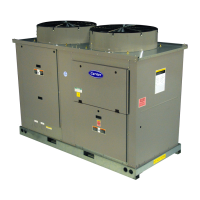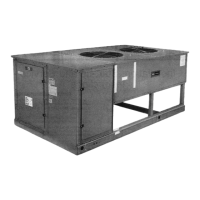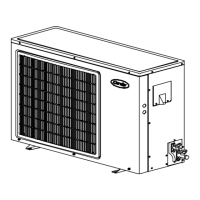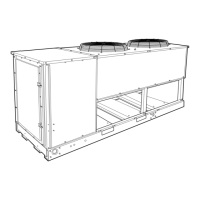111
If the unit is equipped with a digital compressor, it is nor-
mally the first compressor started. If the lead compressor is a
digital compressor, and is enabled and available (not in alarm
or held off by Time Guard), the compressor will start fully
loaded for 90 seconds prior to starting to cycle between loaded
and unloaded. Once the digital compressor is on, positive
changes in LOD.F will cause the compressor to load. Negative
changes to LOD.F will cause the compressor to unload. This
process can occur every 30 seconds. Changes to the digital
loading are not subject to the 90-second delay.
If the unit is equipped with Minimum Load Control, it will
not be active until the unit is on its last stage of capacity. It too
is treated as a stage of compression. As a result, Minimum
Load Control will be activated when capacity is decreasing,
Requested Stage STGE=1, and Capacity Load/Unload Factor
(Run Status
VIEW
LOD.F) is –100% times Deadband
Multiplier (Z.GN).
Similar to increasing STGE from 0 to 1, the control adds a
1.2 factor to the capacity control routine when reducing capaci-
ty from 1 to 0 to reduce cycling.
Thermostat Capacity Stage Control
— This control algo-
rithm is applicable to Control Types Configuration
OPT2
C.TYP=4 (Tstat 2 Stg), or 8 (Dual Tstat). This capac-
ity routine relies on inputs from thermostats to control capacity
staging. See the Sequence of Operation section for the specific
Capacity Control (C.TYP=4, page 69 or C.TYP=8, page 105).
4 to 20 mA Capacity Stage Control
— This control algo-
rithm is applicable to Control Type Configuration
OPT2
C.TYP=7 (Pct Cap). This capacity routine relies on a
4 to 20 mA input from an external source to control capacity
staging. See the Sequence of Operation seection for C.TYP=7
(page 75).
Field Configurable Controls
ALARM ROUTING — A CCN feature within the 38AP
units allows for alarm broadcasting.
Alarm Routing Control
— Alarms recorded on the 38AP
unit can be routed through the CCN. To configure this option,
the ComfortLink control must be configured to determine
which CCN elements will receive and process alarms. Input
for the decision consists of eight digits, each of which can be
set to either 0 or 1. Setting a digit to 1 specifies that alarms will
be sent to the system element that corresponds to that digit.
Setting all digits to 0 disables alarm processing. The factory
default is 00000000. See Figure 144. The default setting is
based on the assumption that the unit will not be connected to a
network. If the network does not contain a ComfortVIEW™,
ComfortWORKS
®
, TeLink, DataLINK™, or BAClink mod-
ule, enabling this feature will only add unnecessary activity to
the CCN communication bus.
The CCN Point ALRM_CNT is the variable and can be
modified with ComfortVIEW software or Network Service
Tool only. It cannot be modified with the scrolling marquee or
Navigator™ display.
Typical configuration of the Alarm Routing variable is
11010000. This Alarm Routing status will transmit alarms to
ComfortVIEW software, TeLink, BAClink, and DataLINK.
Alarm routing is not supported with the LON Translator.
Alarm Equipment Priority
— The ComfortVIEW software
uses the equipment priority value to determine the order in
which to sort alarms that have the same level. A priority of 0 is
the highest and would appear first when sorted. A priority of 7
would appear last when sorted. For example, if two units send
out identical alarms, the unit with the higher priority would be
listed first. The default is 4. The CCN point EQP_TYPE is the
variable and can be changed when using ComfortVIEW soft-
ware or Network Service Tool only. This variable cannot be
changed with the scrolling marquee or Navigator display.
Communication Failure Retry Time
— This variable speci-
fies the amount of time that will be allowed to elapse between
alarm retries. Retries occur when an alarm is not acknowl-
edged by a network alarm acknowledger, which may be either
ComfortVIEW software or TeLink. If acknowledgement is not
received, the alarm will be re-transmitted after the number of
minutes specified in this decision. The factory default for this
item is 10 minutes with a range of 1 to 254 minutes. The CCN
Point RETRY_TM is the variable and can be changed with
ComfortVIEW software or Network Service Tool only. This
variable cannot be changed with the scrolling marquee or Nav-
igator display.
Re-Alarm Time
— This variable specifies the amount of time
that will be allowed to elapse between re-alarms. A re-alarm
occurs when the conditions that caused the initial alarm con-
tinue to persist for the number of minutes specified in this deci-
sion. Re-alarming will continue to occur at the specified
interval until the condition causing the alarm is corrected. To
disable this feature, set the variable to 255. The factory default
is 30 minutes with a range of 1 to 254. The CCN Point RE-
ALARM is the variable and can be changed with Comfort-
VIEW software or Network Service Tool only. This variable
cannot be changed with the scrolling marquee or Navigator
display.
Alarm System Name
— This variable specifies the system
element name that will appear in the alarms generated by the
unit control. The name can be up to 8 alphanumeric characters
long and should be unique to the unit. The factory default is
SPLIT. The CCN point ALRM_NAM is the variable and can
be changed with ComfortVIEW software or Network Service
Tool only. This variable cannot be changed with the scrolling
marquee or Navigator display.
DESCRIPTION STATUS POINT
Alarm Routing 0 0 0 0 0 0 0 0 ALRM_CNT
Building Supervisor,
ComfortVIEW™,
ComfortWORKS
®
,
BACnet Communications (UPC),
BACnet Translator
TeLink,
Autodial Gateway
Unused
Alarm Printer interface Module,
BACLink or DataLINK™
Unused
Fig. 144 — Alarm Routing Control

